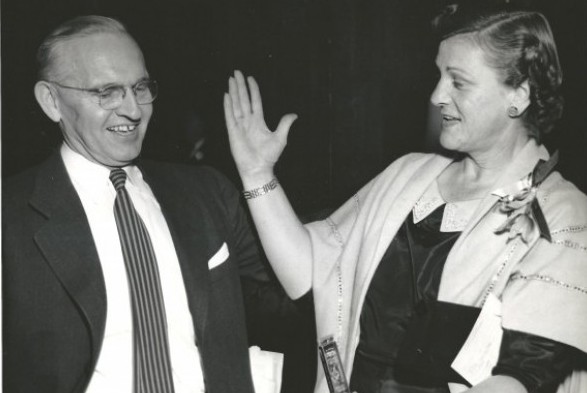
By David Eskenazi and Steve Rudman
Royal Brougham launched the Man of the Year program in 1936 — now the Sports Star of the Year, the 78th edition will take place Jan. 25 at Benaroyal Hall — with the intent of saluting outstanding athletic achievement in the Seattle area in 1935.
To get the process started, Brougham, in one of his ”Morning After” columns in the Seattle Post-Intelligencer, requested that readers submit nominations to help him determine the candidates.
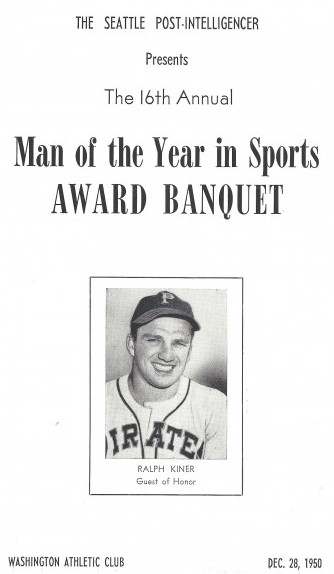
In March 1936, Brougham assembled several cronies to sort through the nominations and declare a winner from a list of 12.
Brougham and his panel, which he came to call The Supreme Court, settled on football/basketball referee Bobby Morris as the first winner (see Wayback Machine: Sports Star of Year (1935-49).
By 1949, with interest growing rapidly in the Man of the Year, Brougham opened his little clambake to the general public.
Two days after Christmas, more than 400 people gathered at the Washington Athletic Club to watch Brougham announce the winner.
For the first time, all of the candidates were on hand, seated at a head table.
By 1950, Brougham’s Supreme Court expanded to 75 individuals, and by 1951 the Man of the Year had outgrown the Washington Athletic Club, where winners were selected since 1936.
So Brougham moved the event, first to the Spanish Ballroom at the Olympic Hotel, then to the Grand Ballroom.
Local television (KING) began airing winner announcements in the 1950s, especially after the program shifted from a day luncheon to an evening dinner.
Two other major differences in the MOY’s complexion from its early years (1935-49) and the 1950s: The flood of women appearing on the MOY ballot, and the sudden rise in popularity of unlimited hydroplane racing.
From 1935-49, “The Supreme Court” placed two women on the Man of the Year ballot. But in the 1950s, 16 women became finalists, two winning.
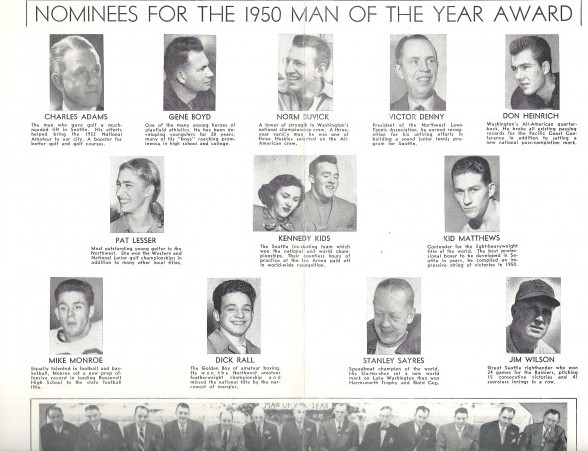
Individuals associated with hydroplane racing appeared on the MOY ballot every year in the 1950s (not even UW football could make that claim).
But no single sport dominated, and many great athletes failed to win, including future members of the college football, basketball and motorsports halls of fame, and Sammy White, the first to appear on the ballot in two sports (basketball, 1945; baseball, 1952).
Winners included three UW football representatives, two basketball players, two golfers (both women), a boxer, a trapshooter, and, to kick off the decade, a man who helped launch a Seattle tradition.
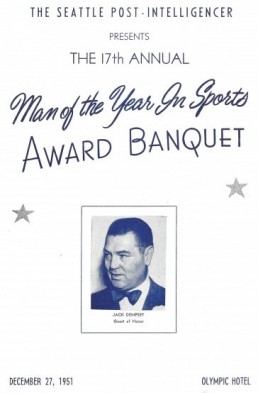
1950 / STAN SAYRES, Hydroplanes
The 1950 MOY ballot included a future member of the College Football Hall of Fame and two future inductees into the U.S. Figure Skating Hall of Fame.
But it did not include an individual who would ultimately sweep into both the College Football Hall of Fame and Pro Football Hall of Fame, Hugh McElhenny, the great University of Washington running back, the first player in school history to rush for more than 1,000 yards.
Starting with 177 yards, including a 91-yard touchdown in UW’s season opener against Kansas State, McElhenny accumulated 1,174 yards and 12 touchdowns, a remarkable 296 of those yards and five of those TDs against Washington State.
Instead of a McElhenny candidacy, Brougham’s “Supreme Court” opted for a Don Heinrich one. McElhenny’s quarterback, Heinrich (College Football Hall of Fame inductee in 1987) was named All-America after setting a national passing record with 134 completions, 14 for touchdowns (see Wayback Machine: ‘Deadeye’ Don Heinrich).
So Heinrich made the first of two appearances on the ballot (also 1952), where he was joined by Seattle-based pairs skaters Peter and Karol Kennedy, the first Americans to win the World Pairs Championship, at Wembley, England (U.S. Figure Skating Hall of Fame, 1991).
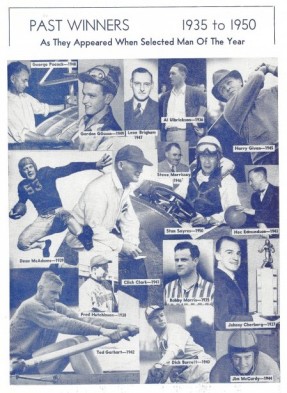
Golfer Pat Lesser made the first of three appearances (also 1952 and 1955) and boxer Harry Kid Matthews (see Wayback Machine: Jack Hurley and Kid Matthews) the first of two (also 1951) after climbing into the national light heavyweight picture by compiling a 14-0 record with nine knockouts.
But Stanley St. Clair Sayres, a well-to-do automobile salesmen, left an impressive field in his backwash, underscoring Seattle’s new-found fascination with hydroplane racing.
No unlimited race had been held in Seattle either before or during 1950, but Ted Jones (see Wayback Machine: Ted Jones Launches A Seattle Tradition) had designed a boat, the Slo-Mo IV, that he and Sayers, who financed its construction, believed capable of winning the prestigious APBA Gold Cup, scheduled for late summer on the Detroit River.
After June 26, 1950, Jones and Sayres knew they had a winner. That day, with Sayres driving and Jones alongside as his riding mechanic, Slo-Mo IV sped through an electronically operated trap off Sand Point (one mile down and one mile back) at an average speed of 160.223 miles an hour.
That toppled by more than 18 mph the 11-year-old standard of 141.74, established by Sir Malcolm Campbell’s Bluebird K4.
Three months later, eight boats engaged in the three-heat, 90-mile Gold Cup, and all that anyone saw of Jones, driving instead of Sayres, was the back of his head.
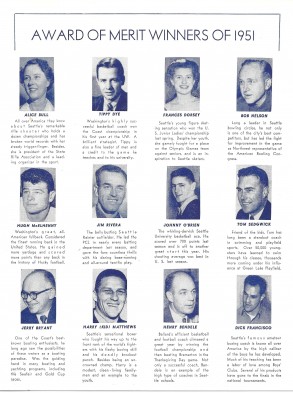
Slo-Mo IV won all three heats, setting a race record of 78.217 mph — actually a spectacular time given the Detroit River’s difficult, dog-leg layout.
The more important point: The Gold Cup winner had the right to select the site for his title defense. Sayers and Jones, representing the sponsoring Seattle Yacht Club, chose Lake Washington.
On Aug. 4, 1951, more than 100,000 people showed up to witness the first unlimited hydroplane race in Seattle history, launching a summer spectacular that is now the centerpiece of Seafair.
Sayres and Jones worked together through design tweaks that resulted in Slo-Mo V and Slo-Mo VI, but Sayers never lived to see Slo-Mo VII.
The 16th Man of the Year died of a heart attack in September of 1956.
1951 / HUGH MCELHENNY, UW Football
Except for George Wilson (1925-27) before him and Jake Locker (2007-10) after him, no player impacted the UW football program more than Hugh McElhenny (see Wayback Machine: Hugh McElhenny & The Kings) and (McElhenny’s 100-Yard Return).
Recognizing that they were unlikely to see the likes of McElhenny again, Royal Brougham’s “Supreme Court” made certain that he made the ballot in 1951, just months after he had completed his 28-game Husky career.
UW basketball coach Tippy Dye, whose Huskies were 24-6 and made an NCAA Tournament appearance, also made the ballot (see Wayback Machine: Tippy Dye’s Life Well Lived) as did Seattle Rainiers star Jungle Jim Rivera (see Wayback Machine: The Rainiers & Pitchers of Beer) and Seattle U. guard Johnny OBrien.
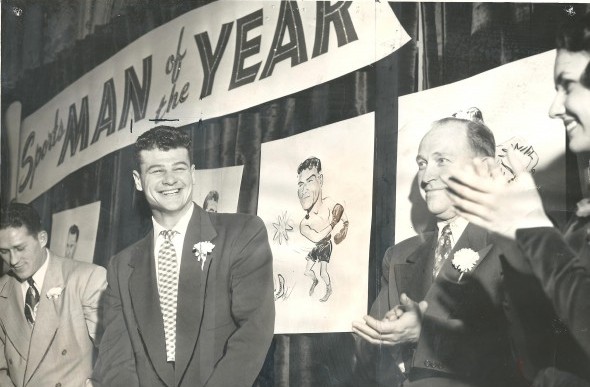
And, for the first time in MOY history, two women, Port Angeles-raised shooter Alice Bull, a one-time captain of the UW women’s rifle team, and figure skater Frances Dorsey, a junior champion who would place second at the 1952 U.S. Championships, found themselves among the final 12.
Rivera, an outfielder for the 1951 PCL champions, represented McElhenny’s main competition. Playing under manager Rogers Hornsby, Rivera hit .352 with 20 home runs and 112 RBIs, stats that made him the franchise’s first league MVP since George Archie in 1940 (see Wayback Machine: Rajah, Rivera, ’51 Rainiers).
But Brougham’s tribunal couldn’t resist McElhenny, the UWs all-time leading rusher, its greatest touchdown producer, and the only player in school history to score on three plays – rush, punt return, kickoff return – of 90 yards or longer.
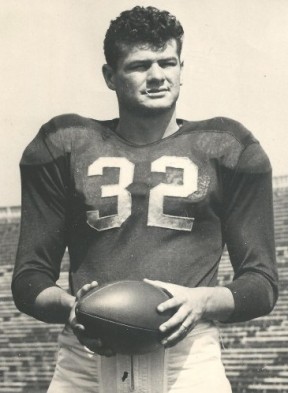
A year after claiming the Man of the Year, McElhenny, who began his NFL career by scoring on a 40-yard touchdown run on his first pro play for the San Francisco 49ers, carted off the NFLs Rookie of the Year award.
Over the ensuing decade, McElhenny would become The King. The Pro Football Hall of Fame welcomed him in his first year of eligibility (1970), and the College Football Hall of Fame inducted him in 1981.
1952 / JOHNNY O’BRIEN, Seattle U. basketball
For the first time in MOY history, an animal, Ardyns Ace of Merwalfin, a black Labrador more familiarly known as Ace The Wonder Dog, and its trainer, Eddie Salvino, made the ballot after Ace won his eighth consecutive Northwest Retriever Trials. But voters couldn’t quite see their way clear to name a dog Man of the Year.
Voters might have opted for second-time nominee Heinrich after he broke his own NCAA record for pass completions (137). Or, they might have gone for Bob Houbregs, who averaged 18.6 points for Tippy Dye’s 25-6 Husky basketball team.
But Seattle U. basketball star Johnny OBrien took the prize, which he effectively wrapped up 11 months before the MOY banquet. On Jan. 21, in front of 12,500 enthralled spectators at Hec Ed Pavilion on the UW campus, OBrien engineered an upset so astonishing that it would be recalled, talked about and written about for more than 50 years (see Wayback Machine: Seattle U. Shocks Globetrotters).
Given his competition for MOY, O’Brien might not have won without an assist from event founder Royal Brougham — despite the fact that O’Brien had also become the first college basketball player to score 1,000 points in a season.
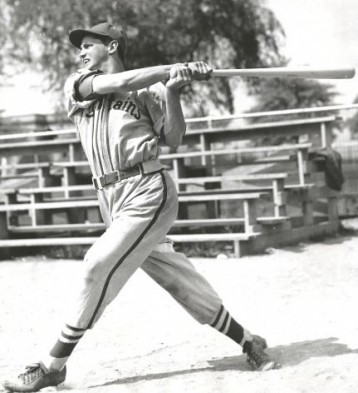
Five days prior to tipoff, Brougham received a telephone call from Howard Hobson, a U.S. Olympic committee member and the head basketball coach at Yale.
Hobson explained that the USOC needed to raise funds to support Americas effort in the 1952 Summer Olympic Games in Helsinki, Finland.
To that end, Abe Saperstein’s Harlem Globetrotters agreed to play three fund-raising contests against college teams in the East (Army), Midwest (Notre Dame) and West.
Hobson asked Brougham if could create the West matchup.
As much a power broker and myth maker as he was sports columnist, Brougham told Hobson he would, informing the USOC official that the Post-Intelligencer would sponsor the charity affair.
Brougham even cheekily promised the USOC the use of UW’s Hec Ed Pavilion without consulting athletic director Harvey Cassill, who was out of town on business and couldn’t be reached. Brougham announced the game in the next day’s newspaper (see Wayback Machine: The Harvey Cassill Era).
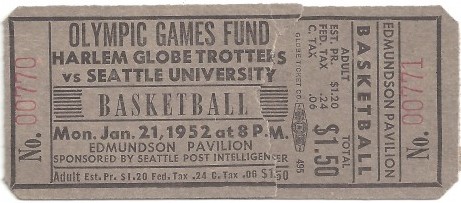
The UW was the obvious choice as the Globetrotters’ opponent. But coach Tippy Dye vetoed the idea, citing too many injuries (no one was aware that the Huskies had any injuries). Dye’s decision might have been influenced by his own squeamishness over the mockery the Globetrotters might inflict on his Huskies. With Washington unavailable, coach Al Brightman’s Chieftains stepped up, a willing substitute (see Wayback Machine: Odd Saga of Al Brightman).
The Globetrotters that would play Seattle U. had already defeated several NBA teams in serious competition. They featured master dribbler Marques Haynes, who had inspired Bob Cousy. Reese Goose Tatum, after playing minor league baseball with Satchel Paige (see Wayback Machine: Satchel Paige In Seattle), joined the Trotters and invented the sky hook, a shot Kareem Abdul-Jabbar would make famous. Tatum had scored 13 points against the Minneapolis Lakers 19 days before playing Seattle U.

The Globetrotters-Seattle U. matchup was supposed to follow the usual Trotters script: They would play semi-seriously until they had a big lead, and then launch into their fancy passing, dribbling and juggling schticks.
But Globetrotters owner Abe Saperstein made a mistake. Just before tipoff, Saperstein wandered underneath Hec Ed’s north stands, where the Chieftains dressed, took one look at Seattle U. players, and asked, ”Is that all you got?”
Dissed, Seattle U. raced to an 8-2 lead, had a 46-36 advantage at the end of two quarters, a 65-59 lead at the end of three and won it 84-81.
Mainly playing center against the taller Tatum, the 5-foot-8 OBrien knocked down right-handed hooks, left-handed hooks and a variety of jumpers in tallying 43 points.
After the game, Saperstein moaned, Me and my big mouth.
Two weeks later, a still-miffed Saperstein cancelled the Trotters appearances in fund-raising games against Army and Notre Dame. And it did not take Saperstein long to ensure that the Globetrotters would never again be subjected to a similar embarrassment.
A few months after Seattle U.s victory, Saperstein asked Louis Red Klotz, a member of the original Baltimore Bullets (1947-48), to form a team to accompany the Globetrotters on their tours. Klotz’s club became the Washington Generals, and they provided the Trotters with deliberately ineffective, and often inept, competition for the next 40 years in large part because of the 1952 Man of the Year, Johnny OBrien.
1953 / ARNIE WEINMEISTER, Ex-UW Football
Arnie Weinmeister played football at UW in 1942 and, following World War II, lettered again 1946-47. In an early December 1953, “Morning After” column in the Post-Intelligencer, Brougham encouraged Weinmeister’s first-time nomination — not for anything Weinmeister had done as a Husky, but what he had done for the New York Giants: Weinmeister was named All-NFL for the third consecutive year, an unprecedented achievement for a former UW player.
Brougham’s “Supreme Court” placed two other intriguing names in nomination: UW basketball coach Tippy Dye, a finalist in 1951, and Bob Houbregs, a first-time finalist in 1952 (see Wayback Machine: Bob Houbregs & The ’53 Final Four).
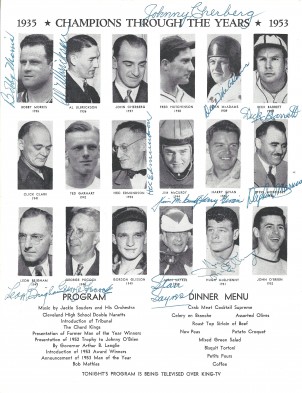
Dye coached the Huskies to a 28-3 record and the school’s first appearance in the Final Four.
But without Houbregs, who led UW in scoring (25.6) and rebounding (11.5) en route to being named the 1953 NCAA Player of the Year, the Huskies never would have reached the national finals in Kansas City.
“The Supreme Court” opted for Weinmeister over Houbregs in a close vote, which meant that the greatest basketball player in UW history would never win the MOY award, a fate that had earlier befallen the UW’s greatest swimmer, Jack Medica, a two-time finalist but never a winner (see Wayback Machine: UW Bonanza At The 1936 Olympics).
Weinmeister played one more year in the NFL (1953) after receiving the MOY, while Houbregs played five in the NBA, injuries cutting short his career. Weinmeister entered the Pro Football Hall of Fame 1984, and the Naismith Basketball Hall of Fame inducted Houbregs in 1987.
The 1953 banquet marked the first time that future members of both the Pro Football and Basketball halls of fame appeared together on the same MOY ballot.
Weinmeister, who spent 36 years with the Teamsters in a variety of positions, died June 29, 2000, at 77.
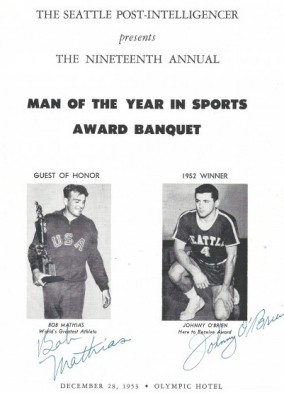
1954 / ARNOLD RIEGGER, Trapshooting
Fascinating about the 1954 Man of the Year is that the ballot did not include a football or basketball nominee (other than a high school coach), and just one baseball candidate, Tommy Byrne (20-10 record, 3.15 ERA), one of few bright spots on a Jerry Priddy-managed Rainiers team that finished 77-85.
But the slate did feature two golfers (Roy Campbell and Eddie Draper), a bowler (Johnny Guenther), a skier (Jannette Burr Bray), and a softball (fastpitch) pitcher (Bob Fesler) (see Wayback Machine: The Bob Fesler Experiment).
The banquet also included a one-minute tribute to a Royal Brougham friend in attendance, Babe Didrikson Zaharias, who listened as Brougham told an audience of 600 that Campbell had shot a stroke under his age (68), that Draper had won the Northwest, Bellingham and Kitsap Open tournaments, that 18-year-old Guenther had rolled an 800 series (highest in Seattle history), and that what Fesler had done was pretty hard to believe.
Fesler had taken the mound at Sicks Stadium the previous summer. Five Seattle Rainiers and five Hollywood Stars took swings at Fesler’s underhand throws, and Fesler struck out every batter, a performance that led the Rainiers, a year later, to sign Fesler to a contract (see Wayback Machine: Rainiers & Pitchers Of Beer).
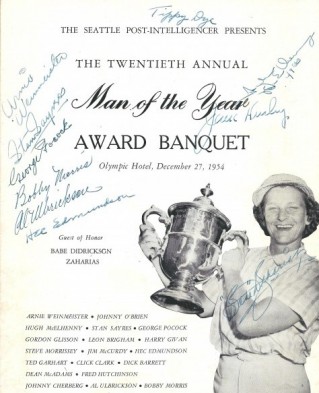
The competition for best athletic effort of 1954 also included the only trapshooter ever to win, Arnold Riegger, coming off his third victory in the Grand American Trapshoot, the Gold Cup/Super Bowl/Olympics of the sport.
Riegger, whom Brougham claimed had the eye of an eagle and the nerve of a burgler, cut a rather odd athletic figure. He stood 5-5, but weighed between 190 and 200 pounds.
He usually wore baggy pants and a wrinkled vest under the kind of green visor that newspaper guys made famous in The Front Page. Riegger also chain-smoked Camels, even during tournaments, and even as he shot, which he did better than anyone.
Reigger once hit 1,429 clay targets consecutively without a miss. Another time, he shattered 1,422 in a row.
During a career that ran from the late 1940s and into the 1960s, Riegger won five 16-yard Washington State Championships, two handicap titles, four doubles crowns and six All-Around State Championships. On five occasions, Riegger led national singles averages, and he made 11 trapshooting All-America teams.
Near the end of the 1954 Grand American, Riegger learned that the Gates (OH.) Gun Club had put up a 1954 Ford to be awarded to the winner of a shoot it planned to host, starting the day after the Grand American ended. Riegger hitchhiked (he liked to hop freight trains to make his way to and from events) to the event and won it, claiming the Ford, and drove it back to the Northwest.
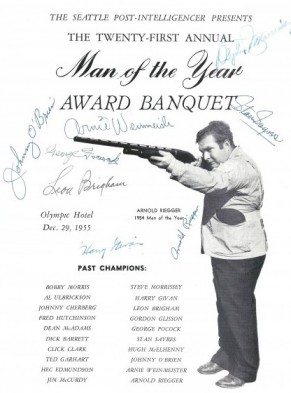
Rieggers’ Man of the Year victory came at the expense of a field that included Bray and Guenther. A skier, Bray had won U.S. national downhill titles in 1948 and 1950, and just missed representing the USA at the 1948 Winter Olympics. She never appeared on the ballot after losing to Riegger.
Guenther would go on to win 11 PBA titles in a career that ran from the early 1960s through the mid-1970s.
He would re-appear on Man of the Year ballots in 1959 and 1966, but not in 1969 after recording his most famous feat: The perfect game he tossed during the championship round of the 1969 San Jose Open in front of ABC-TV cameras and millions of viewers.
Years of dragging on Camels caught up with Riegger. In 1961, at age 41, he was diagnosed with throat cancer. Although afflicted with a disease that would kill him, Riegger still entered tournaments.
Eventually, he couldn’t call “pull” loud enough for a puller to hear him, so he used a crow call and gave a single squawk. Later, he used a whistle, then a voice box with a microphone. Riegger continued to win until the late 1960s, when he called it quits.
The 1954 Man of the Year entered the National Trapshooting Hall of Fame in 1975, and died July 6, 1996, two days shy of his 76th birthday. He spent his final years operating sporting goods outlets in Cowlitz and Clark counties.
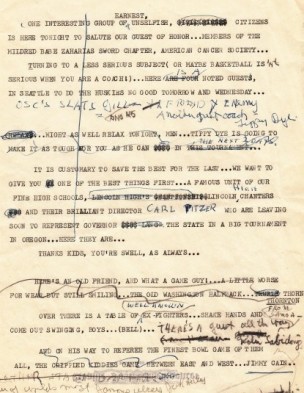
1955 / PAT LESSER, Golf
Twenty-one years after Brougham launched his awards program, a woman finally became Man of the Year.
Pat Lesser, a 22-year-old Seattle University student, was a finalist in 1950, when she lost to Stan Sayres, and again in 1952, when “The Supreme Court” deemed Johnny OBrien’s 43-point spree against the Globettotters simply too good to pass up.
Lesser topped a field that included another woman, tennis player Janet Hopps, hockey player Golden Guyle Fielder of the Seattle Americans (see Wayback Machine: Guyle Fielder and The Seattle Totems), making the first of what would become three MOY finals appearances, and hydroplane designer Ted Jones, making his first appearance on the ballot.
In fact, Jones was also making his last. Unlike another famous boat designer, George Pocock (see Wayback Machine: Hiram Conibear’s Rowing Legacy), who appeared on the MOY ballot four times (finally won in 1948), Jones never got another chance, odd since he was the man most responsible for creating Seattle’s hydroplane tradition (see Wayback Machine: Ted Jones Launches A Seattle Tradition).
Lesser won for capturing the 55th Womens Western Amateur at Olympia Fields CC near Chicago by lopsided 7 & 6 over Carol Diringer, and then scoring a 7 & 6 victory over Jane Nelson, an Indianapolis schoolteacher, at the U.S. Womens Amateur at Myers Park CC in Charlotte, NC.
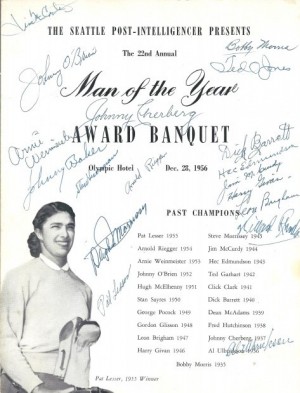
Lesser, who became Pat Lesser Harbottle in 1957 when she married another player on the Seattle University golf team, John Harbottle, had already had an extensive career prior to her U.S. Amateur triumph, and would have a long one after her MOY award.
She had been low amateur at the 1951 and 1953 U.S. Girls Junior Championships, the 1950 Canadian Amateur winner, the 1952 Women’s Western champion, the low amateur at the 1955 Titleholders LPGA event, and the 1955 Washington State Women’s Open champion.
Lesser entered the Pacific Northwest Golf Hall of Fame in 1985 and the State of Washington Sports Hall of Fame in 1999.
1956 / PETE RADEMACHER, Boxing
In order to claim the 1956 award, Pete Rademacher, a 1950-51 football letterman at Washington State University, had to defeat a field that included a future member of the Golf Hall of Fame (JoAnne Gunderson Carner), a future member of the Motorsports Hall of Fame (Bill Muncey), an Olympic swimming medalist (Nancy Ramey), and the Pacific Coast League’s 1956 ERA champion (Elmer Singleton).
But given that Seattle had become a boxing hotbed, largely because of Brougham’s aggressive promotion of annual Gold Glove tournaments, and some of the big-scale fights arranged by promoter Jack Hurley (see Wayback Machine: Jack Hurley & Kid Matthews), it surprised no one that Rademacher strutted off with banquet laurels.
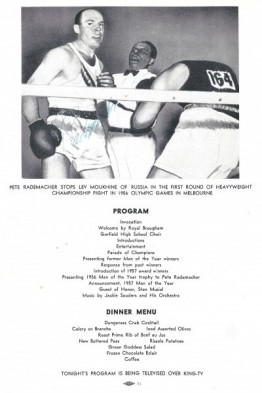
Dating to 1949, even before he played football at WSU, Rademacher won a number of events, including the 1949, 1951, 1952 and 1953 Seattle Gold Gloves.
He won the U.S. Amateur as a heavyweight in 1953, the Chicago Gold Gloves, All-Army Championship and Service Championship in 1956, just weeks before qualifying for the U.S. Olympic team and heading to Melbourne, Australia for the Summer Olympics.
Rademacher’s performance in Melbourne swayed MOY voters. Fighting in the heavyweight division, Rademacher knocked out three consecutive foes — Czechoslovakia’s Josepf Nemec in two rounds, South Africa’s Daan Bekker in three and the Soviet Union’s Lev Mukhin in one — to win the gold medal.
The three consecutive knockouts constituted an Olympic rarity, in that Olympic bouts only last three rounds. Recognizing his feat, the U.S. Olympic Committee had Rademacher carry the American flag in the Closing Ceremonies.
Rademacher produced a 72-7 record as an amateur, far better than he ultimately compiled as a professional, but it was as a pro that he gained his greatest notoriety.
After winning the gold medal, Rademacher promoter Jck Hurley began to trumpet that Rademacher could win the world heavyweight title in his first pro fight. Hurley promoted this idea so persuasively that he was able to lure defending world champion Floyd Patterson into giving Rademacher a title shot, which made Rademacher the first man to fight for the world title in his first pro bout.
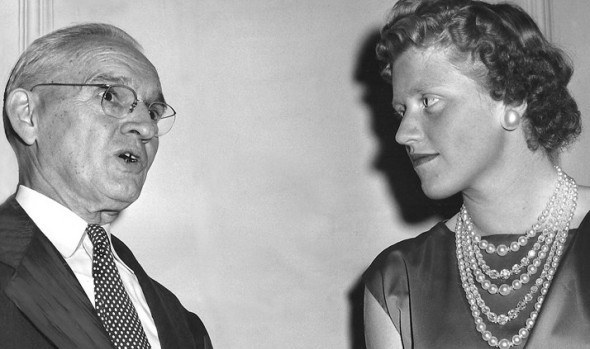
The fight took place Aug. 22, 1957, at Sicks’ Stadium. Rademacher dropped Patterson in the second round, but Patterson recovered, knocked Rademacher down six times and claimed a sixth-round KO.
Rademacher attended numerous MOY banquets following his victory before relocating to Akron, OH., where he became president of the McNeil Corp. He retired from that position in 1987.
1957 / JOANNE GUNDERSON CARNER, Golf
Born April 4, 1939, in Kirkland, JoAnne Gunderson Carner amassed the most impressive resume of any golfer in state history. In winning the 1957 Man of the Year (second woman so honored, following Lesser in 1955), the 18-year-old trumped future Naismith Basketball Hall of Famer Elgin Baylor, then playing for Seattle U., making his first ballot appearance, and Olympic swimmer Nancy Ramey, making her second straight.
As JoAnne Gunderson, known as The Great Gundy until she married Don Carner, JoAnne was the youngest individual ever to appear on a MOY ballot at 17 in 1956. She earned the MOY largely on the basis of having won the 1957 U.S. Women’s Amateur at Del Paso Country Club in Sacramento with an almost absurd 8 & 6 victory over Anne Casey Johnstone.
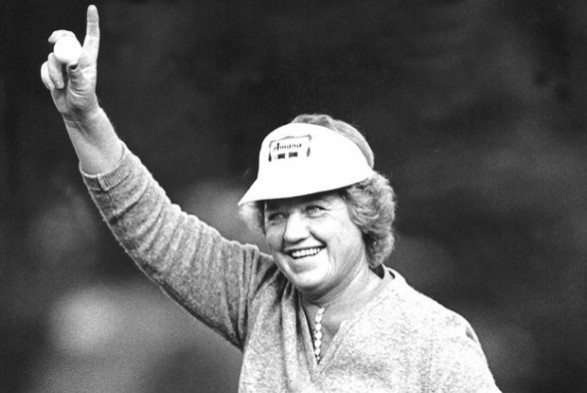
Gunderson-Carner could have won the MOY numerous times after 1957 — in fact, in almost any year through the mid-1980s.
Her win at the 1957 U.S. Women’s Amateur marked her first in that tournament. She also won it in 1960, 1962, 1966 and 1968. Her five wins in the event are one shy of the tournament record, held by Glenna Collett Vare, whose name graces a trophy.
Gunderson-Carner remained an amateur player until 30. Maybe her most notable feat as an unpaid player occurred in 1969, when she won the LPGA’s Burdines Invitational. Gunderson-Carner is the last amateur to win an event on the LPGA tour.
If anything, Carner’s LPGA career exceeded her amateur one. From Sept. 12, 1970, when she defeated Marilynn Smith in a playoff to win the Wendell-West Open, until Sept. 15, 1982, when she scored a two-stroke victory over Jan Stephenson at the Safeco Classic at Meridian Valley, Carner won 43 LPGA events.
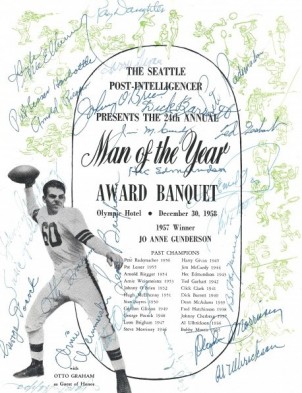
Her biggest wins came in the 1971 and 1976 U.S. Opens, her major awards included the LPGA Player of the Year in 1974, 1981 and 1982, and both of her Hall of Fame inductions came in 1982 (World Golf Hall of Fame and LPGA Hall of Fame).
Carner was good for a very long time: In 2005, at 65, she became the oldest player to compete in an LPGA event.
One other intriguing item about Carner as it relates to the Man of the Year awards: Four years after winning, Carner appeared on the 1960 ballot, but lost to Don McKeta. Carner thus joined rowing coach Al Ulbrickson (1936) as the only individuals to show up on the ballot after winning the MOY (Ulbrickson lost to John Cherberg in 1937; see Wayback Machine: Ralph Welch’s Crazy War Years). In 1963, golfer Anne Quast, a finalist in 1958 and the MOY winner in 1961, showed up on the ballot again and lost to co-winners Jim Whittaker and Brian Sternberg, making her the third winner to appear on the ballot after winning.
(Under modern rules, once an athlete is voted Star of the Year, he or she is ineligible to win it again.)
1958 / ELGIN BAYLOR, Seattle U. Basketball
Three women – cyclist Maxine Conover (U.S. Womens Open champion), golfer Anne Quast (U.S. Amateur champion) and swimmer Nancy Ramey (set a world 100-meter butterfly record) — appeared on the 1958 ballot, a record number for a single year.
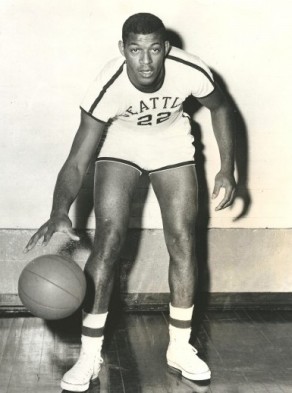
Brougham’s “Supreme Court” also arranged seats at the head table for rower John Sayre, representing the UW crew that shocked the Russian national team in Moscow; Guyle Fielder of the Totems, the Western Hockey Leagues MVP; and 19-year-old outfielder Vada Pinson, who hit .343 for the Seattle Rainiers.
But Elgin Baylor, the Seattle U. phenomenon, stole the show for having led the Chieftains to the NCAA title game against Kentucky. Despite Seattle U’s loss, Baylor was named the Final Fours Outstanding Player after scoring 48 points with 41 rebounds in two games – standard statistical fare for Baylor in 1958 (see Wayback Machine: Seattle U’s 1958 Final 4 Run).
On Jan. 15, in Seattle’s 108-93 win over Montana State, Baylor scored 53 points and grabbed 22 rebounds, after which MSU coach Dobbie Lambert marveled, ”Baylor’s just fantastic. He certainly has a variety of shots, some I’ve never seen before.”
Among Baylor’s other double-doubles: 60 points, 14 rebounds against Portland Jan. 30 in a game in which Baylor scored 20 points in the final seven minutes; 42 points, 19 rebounds against Gonzaga Feb. 7; 46 and 30 in a rematch against the Bulldogs Feb. 8, and 51 points and 37 rebounds against Pacific Lutheran Feb. 28.
Baylor (see Wayback Machines: The Two Lives of Elgin Baylor and A Bakery That Cooked Up Basketball) had one of the greatest careers of any MOY winner: 11-time NBA All-Star, 10-time first-team All-NBA, NBA 35th and 50th Anniversary Teams and, of course, the Naismith Hall of Fame (1977).
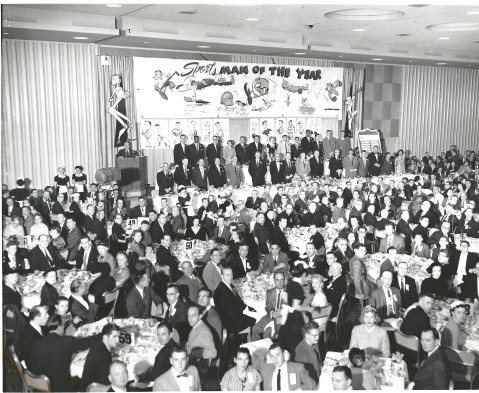
1959 / JIM OWENS, UW Football Coach
Washington went to the Rose Bowl following the 1923, 1925, 1936 and 1944 seasons, each time failing to win what, at the time, was the marquee college football game. So when Jim Owens’ 1959 Huskies decimated Wisconsin 44-8 in the 1960 renewal, it figured that a representative of the 1959 team would have a leg up in MOY voting.
The nod could have gone to quarterback Bob Schloredt, not only the Rose Bowl MVP, but winner of the 1959 W.J. Voit Memorial Trophy as the outstanding college player on the West Coast.
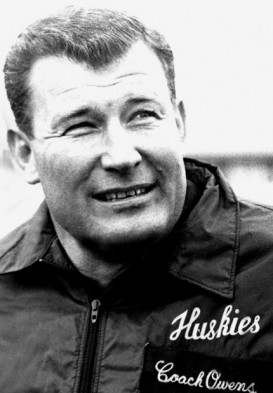
But Brougham’s “Supremes” opted for Owens, who, in just his third year, had coached what had been a downtrodden program before he arrived into the No. 8-ranked team in the land.
Only a 22-15 loss to Southern California Oct. 18 prevented the Huskies (10-1-0) from recording the school’s first perfect season since Gil Dobie’s 1915 team finished 7-0-0 (see Wayback Machine: Tweeting 1911 Style).
The 1959 Huskies not only had four shutouts, they attracted two crowds in excess of 50,000, unheard of at that time. Their popularity ensured that no one else on the MOY slate had a chance to win, regardless of accomplishment.
Rudy Filion, for example, would have been a laudable winner after having led the 1959 WHL champion Totems in regular-season scoring (30 goals, 67 points) and playoff scoring (7 goals, 18 points). And voters might have been tempted to go for future Motorsports Hall of Famer Mira Slovak, The Flying Czech, after he won the prestigious President’s Cup in Washington, D.C. in Bill Boeing Jr.’s Miss Wahoo. But 1959 belonged to Owens and the Huskies.
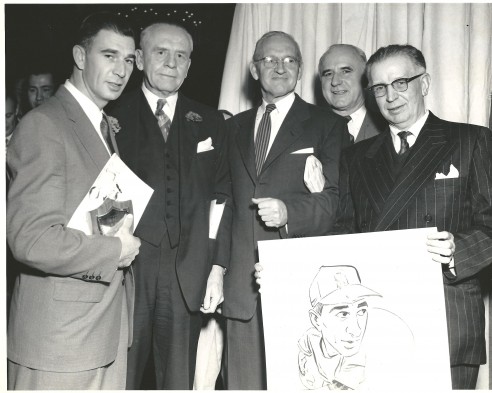
Wayback Machine: Sports Star of the Year: 1935-49)
Man of the Year Winners (1935-76)
Star of the Year Winners (1977-2011)
———————————————-
Many of the historic images published on Sportspress Northwest are provided by resident Northwest sports history aficionado David Eskenazi.Check out Davids Wayback Machine Archive. David can be reached at (206) 441-1900, or at seattlesportshistory@gmail.com
————————————————
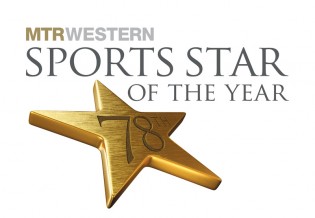 The Seattle Sports Star of the Year awards program is at Benaroya Hall Jan. 25. Created by Royal Brougham and the Seattle Post-Intelligencer in 1936 and currently presented by the Seattle Sports Commission, the Star of the Year recognizes professional and amateur athletic achievement. Tickets can be purchased at benaroyahall.org or by calling 206-215-4747. The top-priced ticket includes admission to the show and the reception where complimentary beverages, including beer and wine, and heavy appetizers will be provided. You can find more information here. For information about how (and for whom) to vote, go to this page.
The Seattle Sports Star of the Year awards program is at Benaroya Hall Jan. 25. Created by Royal Brougham and the Seattle Post-Intelligencer in 1936 and currently presented by the Seattle Sports Commission, the Star of the Year recognizes professional and amateur athletic achievement. Tickets can be purchased at benaroyahall.org or by calling 206-215-4747. The top-priced ticket includes admission to the show and the reception where complimentary beverages, including beer and wine, and heavy appetizers will be provided. You can find more information here. For information about how (and for whom) to vote, go to this page.

5 Comments
Wow! What an star-studded line up at the ’58 banquet! Royal Brougham really did so much for sports in Seattle. He even influenced greatly another great Seattle sports scribe in Bill Knight. Great article.
Wow! What an star-studded line up at the ’58 banquet! Royal Brougham really did so much for sports in Seattle. He even influenced greatly another great Seattle sports scribe in Bill Knight. Great article.
What a decade. All these stories on the award are interesting. I’ve linked to this page from a page at the Jack Gordon site (jackgordon.org/Visits/JackDempsey.htm).
We appreciate the link. Thanks for visiting our web site.
What a decade. All these stories on the award are interesting. I’ve linked to this page from a page at the Jack Gordon site (jackgordon.org/Visits/JackDempsey.htm).